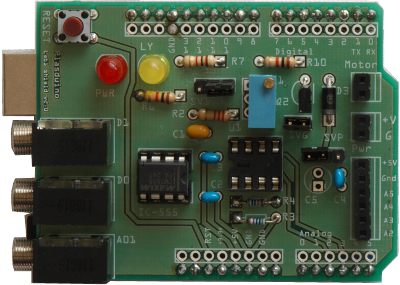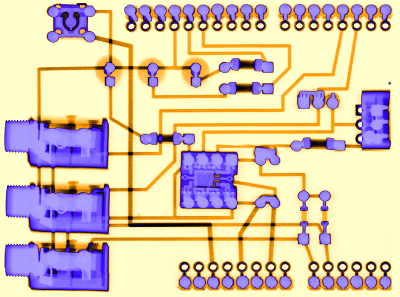Lab 1

This shield is designed for the lab course for the freshmen at the physics department of the University of Pisa. We currently use it mainly for a set of mechanics and thermodynamics didactic experiments.
Version 2 (October 2013)
- Data sheet (pdf).
- Production files: Fritzing file, etchable pdf, gerber, part list.
Version 1 (December 2012)
- Data sheet (pdf).
- Production files: Fritzing file, etchable pdf, gerber, part list.
Features
The main purpose of the the shield is to provide a convenient interface between the arduino I/O ports and the external world. In fact the shield provides mini-jack connectors for two optical gates and a pair of 10 kOhm thermistors, along with generic in-line female pins providing access to four arduino analog inputs, distributing the +5V and providing a PWM power output (through an external power supply) to drive a motor.
A IC-555 timer provides a square wave, whose frequency is adjustable (roughly between 1 Hz and a few kHz) through the R1 potentiometer, that can be used to test the functionality of the assembly and to measure the time jitter of the system. The IC-555 output can be fed to the D2 arduino digital input by switching the jumper on SV1 (by default the D2 arduino pin is connected to the proper pin of the D0 female mini-jack on the shield).

The shield provides all the circuitry to modulate the voltage from an external power supply (provided on the Pwr input connector) with the PWM from the arduino D9 digital output. This allows to drive an external motor (changing the duty cycle of the PWM on the arduino D9 controls the speed of the motor itself).
Finally, the shield provides a red (PWR) led signaling that the assembly is powered up and a general-purpose yellow (LY) led connected to the arduino D13 output pin that can be used in the sketches. A reset button completes the board.
X-ray image of the shield
Since we work in a High-Energy Physics lab, we can have easy access to radiation sources and detectors. So why not playing with our instrumentations and make an x-ray image of the shield? The result is in the picture on the left.